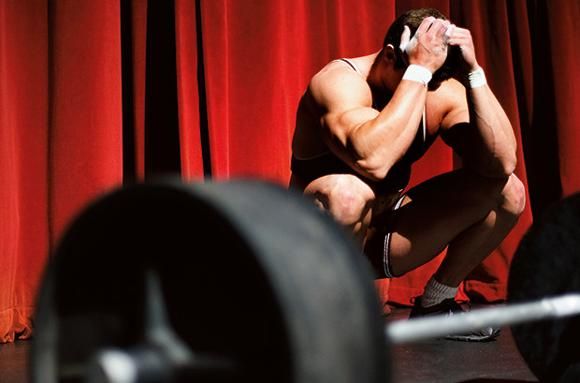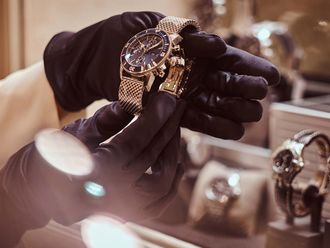
Pradeep Bala looked in the mirror and flexes his biceps. He shook his head in shame, detesting the image staring back at him.
The bulging muscles that rippled across his body were not what he’d hoped to see – not this time or the other seven or eight times he’d stood in front of the mirror that day.
Pradeep, who lives alone in London, is a big guy with the honed torso of a highly trained bodybuilder: broad chest and shoulders, powerful thighs, and shapely muscles running down his arms.
But he was not satisfied.
‘I still don’t think I’m muscular enough,’ he says. ‘I need to do some serious work to get in shape and be appreciated by others.’
Pradeep, 27, has been addicted to muscle ever since he saw images of male models on the covers of men’s magazines more than a decade ago. ‘I began thinking that if it’s attainable for them, surely I too could get a similar physique in my own right,’ he says.
More than eight years of rigorous workouts in the gym have left him with an enviable body, but he is still not happy. ‘I’m sure I can do better and have a better body.’
Pradeep is not vain, nor is he alone. He is suffering from bigorexia – a condition called muscle dysmorphia or inverse anorexia, which affects thousands of people, mainly men, around the world.
The significant increase in the number of people working out at the gym has coincided with the rapid rise in media images of masculine attractiveness. Typically, they feature well-groomed men with muscular physiques sporting a perfect V-shaped body and a six pack.
But, for some, the appeal of such an appearance has developed into a compulsive addiction, leading to steroid abuse, depression and even death.
Now experts are warning that men must find a happy balance between not caring about their appearance, and obsessing about it to the point of jeopardising their health.
The Body Dysmorphic Disorder Foundation believes one in 10 men training in UK gyms have the condition, with instances rising and many more cases going unreported. ‘There are thousands upon thousands of people with it, who are going to be excessively concerned about their appearance, having very poor self-esteem, and also feeling very anxious and very worried,’ says Rob Willson, chair of the Body Dysmorphic Disorder Foundation. ‘Sometimes, individuals can become very depressed and hopeless and that can even lead to suicide.
‘Muscle dysmorphia is a preoccupation with the idea that one isn’t big enough, isn’t muscular enough.
‘There are all these media pressures around now. It might be that women are better adjusted to them and men have to catch up a bit in terms of coping with the strain of looking a certain way.
‘Why some men develop muscle dysmorphia and others don’t is a bit of a million-dollar question, but there are some theories, such as people being bullied or teased, or maybe another family member has a psychiatric condition – OCD or depression – which might have been a vulnerability factor.’
Little is known about the condition at this stage. There are views that it may be genetic or caused by a chemical imbalance in the brain. There have also been suggestions that life experiences may play a role, with a possible link to suffering from bullying or child abuse.
Dr Sheri Jacobson, a senior psychotherapist with more than 30 years’ experience, who works at Harley Therapy, a London centre that treats people suffering from emotional health issues, finds it encouraging that more people are now willing to discuss the condition and raise awareness of its dangers.
‘Anything to do with excess can be dangerous, especially in the sphere of appearance – body image and weight,’ she says. ‘There’s a spectrum; the further to the end you reach, the more dangerous it can be. It’s reasonable for a man to want to develop his muscularity, but we want to reach a midway part on the spectrum – not where people don’t bother about what they look like and neither at the other extreme where it jeopardises their life.
‘We want to reach equilibrium where health is put above appearance.’
Bigorexia is probably the manifestation of a more deep-seated unhappiness in an individual, triggered by an abusive incident or emotional issue in earlier life, she adds. ‘Exercise releases endorphins, which make us feel good and can become an addiction.
‘As a society, we don’t judge exercise addiction as much as we would, say, addiction to alcohol or gambling and that’s because of the perceived health benefits of working out. However, it can have equally destructive consequences both on the body (ruptures, kidney and liver failure) and the mind in the form of aggression, depression and anxiety.
‘While images in fitness magazines and the media might be a factor in the rise of bigorexia, I believe it is more likely to be triggered in some people than others based on their earlier experiences.
‘A cycle of dysfunctional thoughts is characteristic of body dysmorphia and makes it very hard to escape.’
Experts say there has been a big push in people against being lazy and slovenly by going to the gym. ‘It takes a lot of self-sacrifice and discipline to train, so it gives signals of being productive on the surface,’ says Dr Jacobson. ‘But it’s this excess that’s dangerous.’
Pradeep realised his interest in working out and following a strict diet to boost his body image had become problematic about 10 years ago. ‘It was something I initially brushed off,’ he says. ‘I couldn’t and wouldn’t accept the fact that bigorexia even existed and I had a problem.
‘It was only years later, when I watched a few documentaries and the term came about that I realised I might have an issue.
‘I was dissatisfied with no matter what I saw in the mirror, no matter who told me I looked good. My eye was never pleased, and it took a really wrong turn. I lost friends, I left friends, I would shut myself off, I wouldn’t talk to anyone, I wouldn’t pick up phone calls, would not answer emails.
‘I’d go about my day in silence, just wake up, do the work I had to get done, train, sleep – that’s it.
‘I felt I needed to completely block out my social life to make sure that I am mentally satisfied to some degree. Only then would I feel some self-worth to go talk to people, to say I’m OK now.’
Pradeep is better able to manage his condition now, but he still has frequent ‘vicious internal dialogues’ asking himself why he is so small and not focusing on his regime.
‘It will be a very negative discussion that will slowly plummet me into further anxiety and depression,’ he says. On a daily basis, the lows are when I overly critique myself to the point where I just think nothing looks right. It bothers my mind because I don’t like what I’m seeing. I’ve taken a visual red marker and analysed every single part. It’s more than neurotic – it’s a detriment to my mental state.
‘There were several times in my life – most recently a few months ago – when I looked in the mirror and was disgusted with myself.
‘This is why I remain very humble. When I’m in the gym, I’m in a hoodie, I don’t ask for any attention, I ask for no sympathy, I ask no one to boast about me, I just want to go about my business.’
Dr Jacobson urges anyone concerned about their own obsession – or that of a loved one – to seek urgent help. ‘Otherwise, we could be talking death,’ she warns.
‘If they seek and receive help, the hope is they can look back and think that was what saved them.’
Her clinic offers about 1,000 appointments a month but currently, none are taken by people suffering from bigorexia, which she says might be encouraging – but she is more sceptical. ‘I have a feeling it’s more common and just going untreated. Some people undergo too much plastic surgery. They go through excessive procedures to feel good, but it’s often masking an internal world, which is in disarray.
‘If you are psychologically healthy and grounded in life, you feel able to take the knocks, but if that core is shaky, it only takes a slight knock to lead to unhealthy patterns, addictions and compulsions.
‘Compulsive behaviour is at our doorsteps – it’s usually short-lived like a diet and then we get our life back in balance.’
The psychotherapist also mentions the method of treatment. ‘How we try to treat people who have gone down the route of excess is we dig deep to find the root of their anxiety and then tackle the obsession.
‘We need to contend with the underlying factors first, listen to what’s meaningful for the individual and provide a supportive and nurturing environment.
‘Our bodies are wired to habits and it’s very hard to change a habit – there are no quick fixes. Seeking change is a big commitment with no instant rewards.
‘My message is: try to be receptive to the concerns of others about our habits. It hurts to hear criticisms, and we will want to deny them, but they could serve us better in the long run.’
Adam’s story
Amateur bodybuilder Adam Trice, 31, from Yorkshire, UK, was obsessed with getting a bigger, more muscular frame. He had bigorexia and his quest for the perfect body meant he was constantly in the gym and using harmful steroids.
‘I started off at 76.2kg, and my goal was 95.2kg,’ he says. ‘I got there, but then it was 108kg, then 121kg, and so on. You’re always striving for something else, the goalpost is constantly moving.’
Adam’s condition lost him his job, girlfriend and home. Eventually, he became so depressed that he tried to commit suicide.
‘I was unhappy; I didn’t have peace in my life,’ he recalls. ‘I was not dealing with my problem and I tried to take my own life. I was in a really dark place.’
Adam ended up in hospital and had to seek professional help.
‘I had a lot of therapy, did a lot of work on myself and found out a lot about myself. I learnt to like myself.’
Many bigorexia sufferers turn to anabolic steroids, which boost their muscle mass and decrease fat. But these have harmful side effects like hair loss, infertility, high cholesterol, aggressive behaviour, mood swings and increased risk of heart and liver problems.
Oli’s story
Oli Loyne was 18 when he started taking steroids to get a bigger physique. His mother, Sarah, says his bigorexia may have been trigged by insecurities over his height. ‘It was a lot to do with the fact he was so short,’ she says. ‘He was about 158cm. He didn’t have the height and he wanted to make up for that by being as wide as he could.
‘He always said he’d never get a girlfriend. I’d say there’s nothing wrong with you – you’re beautiful, you’re gorgeous. He wanted the width, to prove to himself that he could be this person if he wanted to be.’
Oli’s excessive training and steroid use led to two heart attacks and a stroke when he was just 19. He quickly returned to his punishing regime and died after a third heart attack at 20.
‘There was just no getting through to him,’ says Sarah, in tears. ‘No getting through about what he was doing to his body. It was like a drug. He was like “I need to look like the image in my head. I need to look big”.’












